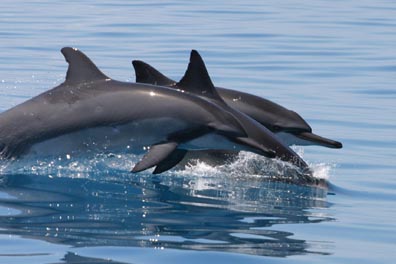|
You
are here: /main/research
expeditions/May 2005/Day 3 Pearl
and Hermes
Day
3, Pearl and Hermes Atoll
by Kelly Gleason, Maritime Archaeology Team

Spinner dolphins.
In
the words of Dr. Brian Bowen of the fish team, today’s
weather was “perfect.” The waters around Pearl
and Hermes Atoll were calm and glassy and this made everyone’s
work today successful. Today, the fish team was accompanied
by photographer John Brooks who is taking footage of the Northwestern
Hawaiian Islands and the work that the scientists are conducting
for the purposes of educational videos. John was able to get
great footage of the masked angelfish, a Hawaiian endemic,
during at 50 foot dive. Seeing masked angelfish at this depth
is extremely rare. In the main Hawaiian Islands, one usually
sees these fish in hundreds of feet of water, however, in
the Northwestern Hawaiian Islands, these fish occur at much
shallower depths.
In
addition to their fish sampling, the fish team collected data
for population connectivity of spinner dolphins. This is the
subject of Kim Andrews, a graduate student at the University
of Hawaii’s dissertation, and the fish team was helping
her out by taking biopsy samples of the dolphins to determine
if the dolphins move between isolated ecosystems. Through
Kim’s research, she has been finding that the dolphins
at Pearl and Hermes Atoll are fairly isolated. Collecting
samples from dolphins requires different methodology from
the fish team’s usual strategies. Dolphins tend to be
creatures of habit. At night they spend their time outside
of the lagoon, while during the day they come inside the lagoon
to rest and socialize. The fish team inspires them to come
closer by coming up fast along side the dolphins so that they
begin to bow ride, at which point the team takes a small sample
of the dolphin’s DNA with a biopsy dart gun.
The
fish team had a busy day. In addition to the dolphin biopsy
sample collections, Dr. Carl Meyer, Dr. Randy Kosaki, and
Yannis Pappastamatiou continued to tag fish. Today, they piqued
the curiosity of two large tiger sharks, but were unable to
lure them in close enough to implant the transponders. The
tagging team was successful in implanting transponders into
two Uku (a type of green jobfish). After coming in from the
field, teams unload gear and get ready to eat whatever amazing
meal that the chief steward has created for us each night.
But the day’s work is never really complete at meal
time. Hours of processing and work in the labs continues into
the night. Brian and Jeff are busy processing the fish samples
in the dry lab, taking fin clips and putting it into preservative

Fin clip.
Carl
and Yannis spend the evenings entering data from the day and
prepping for the next day. Careful preparation is essential,
and it usually includes getting all of the field kits ready.
The surgery kit needs to be redone each day, and the fishing
kit and receiver deployment kit need to be properly outfitted
before each day of work in the field.
Meanwhile,
the maritime archaeology team spent the day expanding the
boundaries of the two shipwreck sites they have been working
on for the last two days to include areas inside of the reef.
It is amazing how violent wrecking events on the atolls were.
Ships that run aground onto the reef scatter artifacts for
hundreds of meters. Locating all of the artifacts in the short
time that we have at this atoll is an exciting challenge.
The team continued to document and interpret parts of the
expansive wrecksites.

Kelly and Tane mapping the wreck site.
The
coral disease team successfully established two more permanent
transects at Pearl and Hermes Atoll today, and noticed bleaching
occurring on Montipora capitata (brown rice coral).
As the leader of the coral disease team, Greta Aeby is attempting
to answer questions such as whether the bleaching that they
are seeing is a new phenomena related to climate change, or
if it has always been happening and its just that no one has
been observing these occurrences. These are important questions
with implications for the management of these resources. The
work scientists are conducting off of the Hi’ialakai
on a daily basis have implications far beyond individual studies
or reports. All scientists on the ship have hopes that their
work will contribute to the effective management of the remarkable
resources in the Northwestern Hawaiian Islands.
|